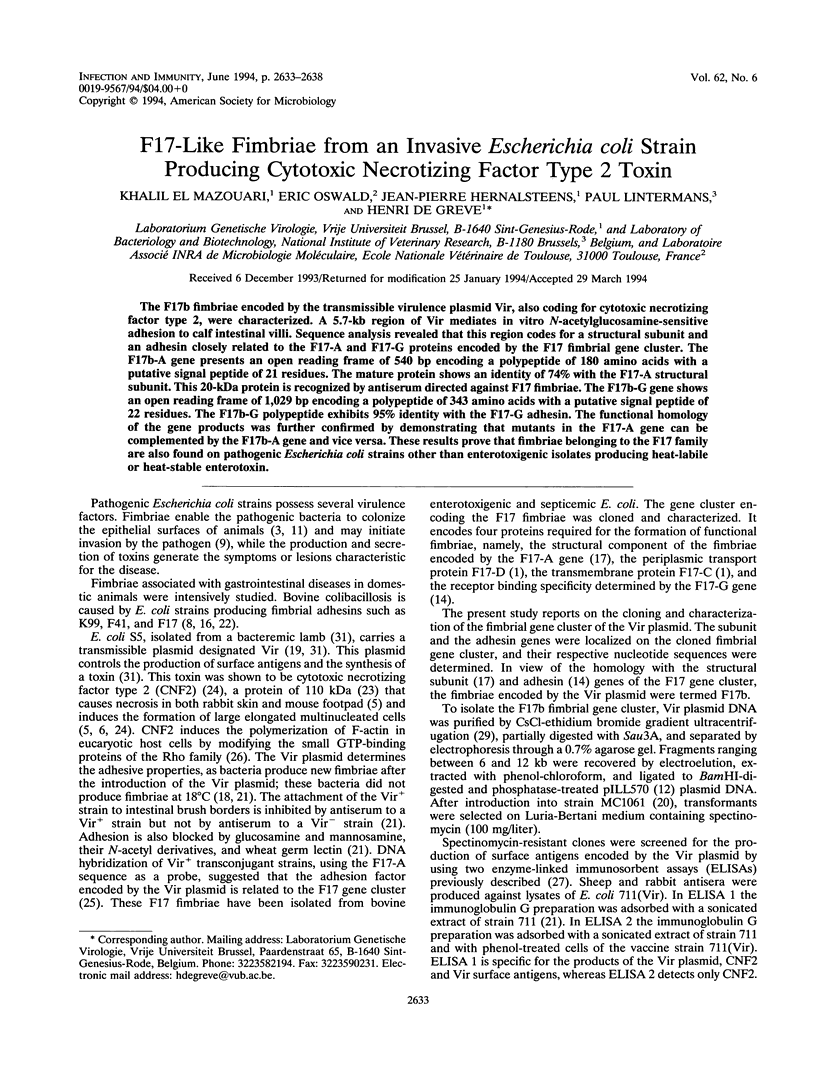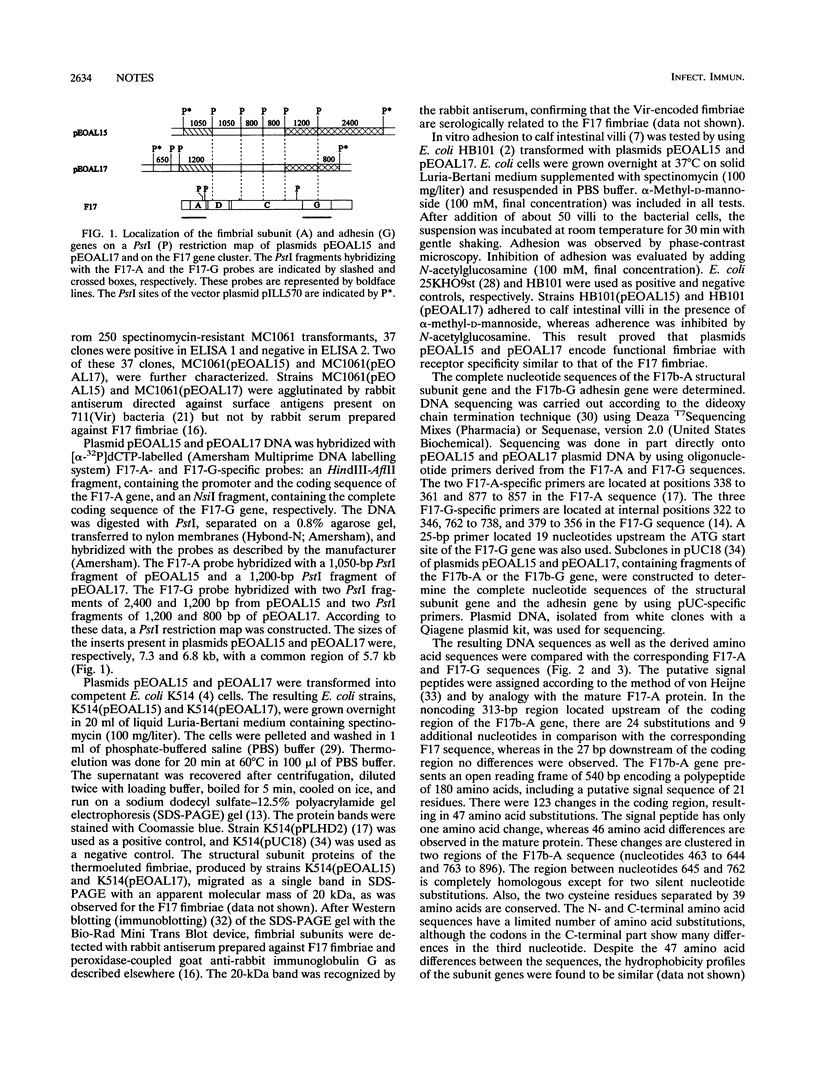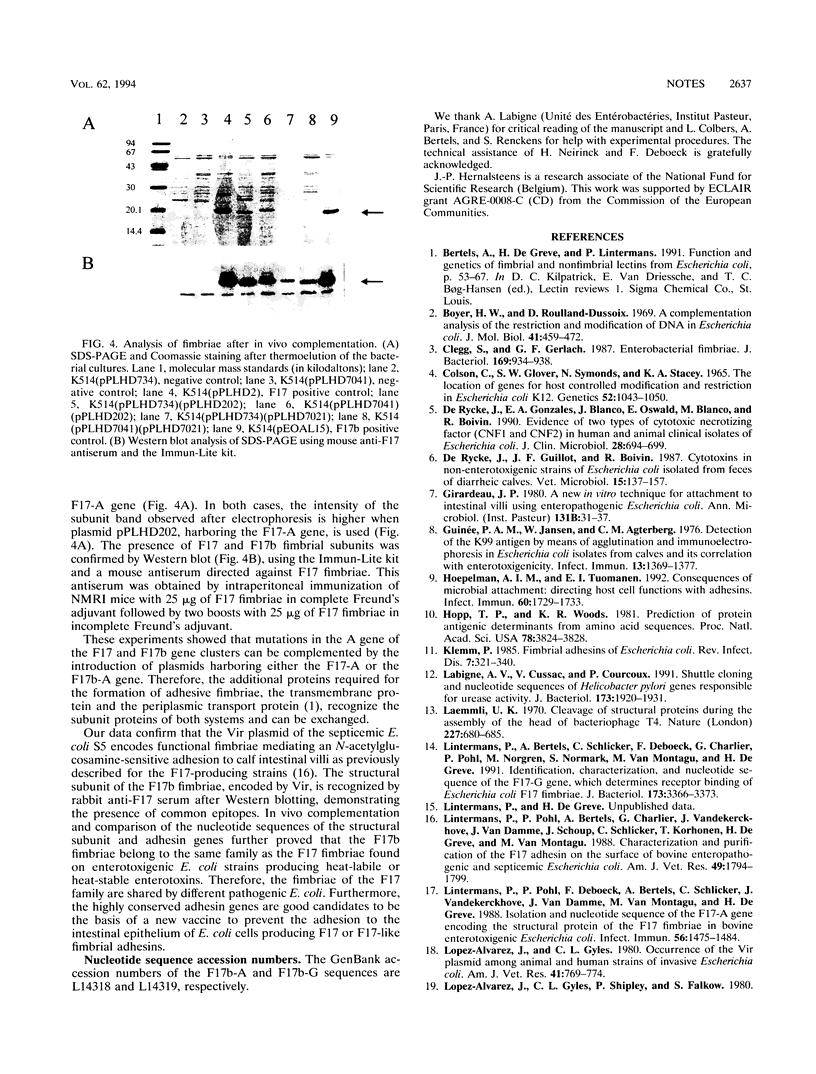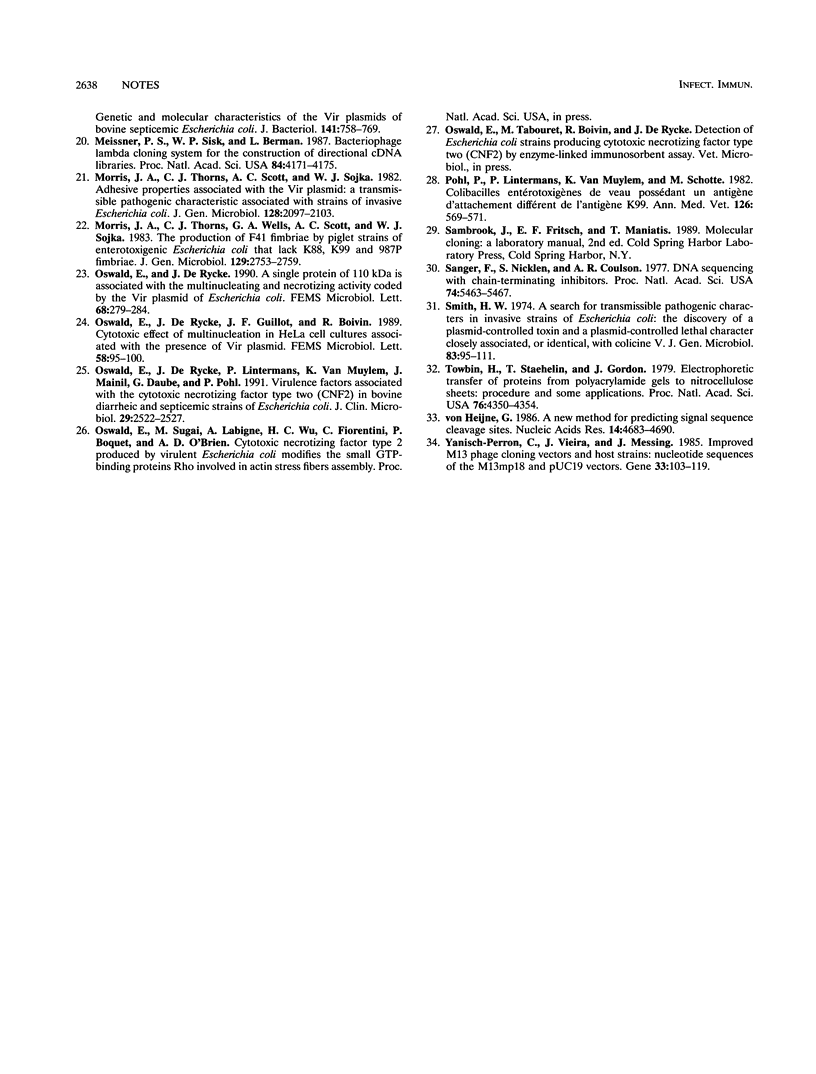Abstract
The F17b fimbriae encoded by the transmissible virulence plasmid Vir, also coding for cytotoxic necrotizing factor type 2, were characterized. A 5.7-kb region of Vir mediates in vitro N-acetylglucosamine-sensitive adhesion to calf intestinal villi. Sequence analysis revealed that this region codes for a structural subunit and an adhesin closely related to the F17-A and F17-G proteins encoded by the F17 fimbrial gene cluster. The F17b-A gene presents an open reading frame of 540 bp encoding a polypeptide of 180 amino acids with a putative signal peptide of 21 residues. The mature protein shows an identity of 74% with the F17-A structural subunit. This 20-kDa protein is recognized by antiserum directed against F17 fimbriae. The F17b-G gene shows an open reading frame of 1,029 bp encoding a polypeptide of 343 amino acids with a putative signal peptide of 22 residues. The F17b-G polypeptide exhibits 95% identity with the F17-G adhesin. The functional homology of the gene products was further confirmed by demonstrating that mutants in the F17-A gene can be complemented by the F17b-A gene and vice versa. These results prove that fimbriae belonging to the F17 family are also found on pathogenic Escherichia coli strains other than enterotoxigenic isolates producing heat-labile or heat-stable enterotoxin.
Full text
PDF





Images in this article
Selected References
These references are in PubMed. This may not be the complete list of references from this article.
- Boyer H. W., Roulland-Dussoix D. A complementation analysis of the restriction and modification of DNA in Escherichia coli. J Mol Biol. 1969 May 14;41(3):459–472. doi: 10.1016/0022-2836(69)90288-5. [DOI] [PubMed] [Google Scholar]
- Clegg S., Gerlach G. F. Enterobacterial fimbriae. J Bacteriol. 1987 Mar;169(3):934–938. doi: 10.1128/jb.169.3.934-938.1987. [DOI] [PMC free article] [PubMed] [Google Scholar]
- Colson C., Glover S. W., Symonds N., Stacey K. A. The location of the genes for host-controlled modification and restriction in Escherichia coli K-12. Genetics. 1965 Nov;52(5):1043–1050. doi: 10.1093/genetics/52.5.1043. [DOI] [PMC free article] [PubMed] [Google Scholar]
- De Rycke J., González E. A., Blanco J., Oswald E., Blanco M., Boivin R. Evidence for two types of cytotoxic necrotizing factor in human and animal clinical isolates of Escherichia coli. J Clin Microbiol. 1990 Apr;28(4):694–699. doi: 10.1128/jcm.28.4.694-699.1990. [DOI] [PMC free article] [PubMed] [Google Scholar]
- De Rycke J., Guillot J. F., Boivin R. Cytotoxins in non-enterotoxigenic strains of Escherichia coli isolated from feces of diarrheic calves. Vet Microbiol. 1987 Oct;15(1-2):137–150. doi: 10.1016/0378-1135(87)90139-8. [DOI] [PubMed] [Google Scholar]
- Girardeau J. P. A new in vitro technique for attachment to intestinal villi using enteropathogenic Escherichia coli. Ann Microbiol (Paris) 1980 Jul-Aug;131B(1):31–37. [PubMed] [Google Scholar]
- Guinée P. A., Jansen W. H., Agterberg C. M. Detection of the K99 antigen by means of agglutination and immunoelectrophoresis in Escherichia coli isolates from calves and its correlation with entertoxigenicity. Infect Immun. 1976 May;13(5):1369–1377. doi: 10.1128/iai.13.5.1369-1377.1976. [DOI] [PMC free article] [PubMed] [Google Scholar]
- Hoepelman A. I., Tuomanen E. I. Consequences of microbial attachment: directing host cell functions with adhesins. Infect Immun. 1992 May;60(5):1729–1733. doi: 10.1128/iai.60.5.1729-1733.1992. [DOI] [PMC free article] [PubMed] [Google Scholar]
- Hopp T. P., Woods K. R. Prediction of protein antigenic determinants from amino acid sequences. Proc Natl Acad Sci U S A. 1981 Jun;78(6):3824–3828. doi: 10.1073/pnas.78.6.3824. [DOI] [PMC free article] [PubMed] [Google Scholar]
- Klemm P. Fimbrial adhesions of Escherichia coli. Rev Infect Dis. 1985 May-Jun;7(3):321–340. doi: 10.1093/clinids/7.3.321. [DOI] [PubMed] [Google Scholar]
- Labigne A., Cussac V., Courcoux P. Shuttle cloning and nucleotide sequences of Helicobacter pylori genes responsible for urease activity. J Bacteriol. 1991 Mar;173(6):1920–1931. doi: 10.1128/jb.173.6.1920-1931.1991. [DOI] [PMC free article] [PubMed] [Google Scholar]
- Laemmli U. K. Cleavage of structural proteins during the assembly of the head of bacteriophage T4. Nature. 1970 Aug 15;227(5259):680–685. doi: 10.1038/227680a0. [DOI] [PubMed] [Google Scholar]
- Lintermans P. F., Bertels A., Schlicker C., Deboeck F., Charlier G., Pohl P., Norgren M., Normark S., van Montagu M., De Greve H. Identification, characterization, and nucleotide sequence of the F17-G gene, which determines receptor binding of Escherichia coli F17 fimbriae. J Bacteriol. 1991 Jun;173(11):3366–3373. doi: 10.1128/jb.173.11.3366-3373.1991. [DOI] [PMC free article] [PubMed] [Google Scholar]
- Lintermans P. F., Pohl P., Bertels A., Charlier G., Vandekerckhove J., Van Damme J., Schoup J., Schlicker C., Korhonen T., De Greve H. Characterization and purification of the F17 adhesin on the surface of bovine enteropathogenic and septicemic Escherichia coli. Am J Vet Res. 1988 Nov;49(11):1794–1799. [PubMed] [Google Scholar]
- Lintermans P., Pohl P., Deboeck F., Bertels A., Schlicker C., Vandekerckhove J., Van Damme J., Van Montagu M., De Greve H. Isolation and nucleotide sequence of the F17-A gene encoding the structural protein of the F17 fimbriae in bovine enterotoxigenic Escherichia coli. Infect Immun. 1988 Jun;56(6):1475–1484. doi: 10.1128/iai.56.6.1475-1484.1988. [DOI] [PMC free article] [PubMed] [Google Scholar]
- Lopez-Alvarez J., Gyles C. L. Occurrence of the vir plasmid among animal and human strains of invasive Escherichia coli. Am J Vet Res. 1980 May;41(5):769–774. [PubMed] [Google Scholar]
- Lopez-Alvarez J., Gyles C. L., Shipley P. L., Falkow S. Genetic and molecular characteristics of Vir plasmids of bovine septicemic Escherichia coli. J Bacteriol. 1980 Feb;141(2):758–769. doi: 10.1128/jb.141.2.758-769.1980. [DOI] [PMC free article] [PubMed] [Google Scholar]
- Meissner P. S., Sisk W. P., Berman M. L. Bacteriophage lambda cloning system for the construction of directional cDNA libraries. Proc Natl Acad Sci U S A. 1987 Jun;84(12):4171–4175. doi: 10.1073/pnas.84.12.4171. [DOI] [PMC free article] [PubMed] [Google Scholar]
- Morris J. A., Thorns C. J., Scott A. C., Sojka W. J. Adhesive properties associated with the Vir plasmid: a transmissible pathogenic characteristic associated with strains of invasive Escherichia coli. J Gen Microbiol. 1982 Sep;128(9):2097–2103. doi: 10.1099/00221287-128-9-2097. [DOI] [PubMed] [Google Scholar]
- Morris J. A., Thorns C. J., Wells G. A., Scott A. C., Sojka W. J. The production of F41 fimbriae by piglet strains of enterotoxigenic Escherichia coli that lack K88, K99 and 987P fimbriae. J Gen Microbiol. 1983 Sep;129(9):2753–2759. doi: 10.1099/00221287-129-9-2753. [DOI] [PubMed] [Google Scholar]
- Oswald E., De Rycke J. A single protein of 110 kDa is associated with the multinucleating and necrotizing activity coded by the Vir plasmid of Escherichia coli. FEMS Microbiol Lett. 1990 Mar 15;56(3):279–284. [PubMed] [Google Scholar]
- Oswald E., De Rycke J., Guillot J. F., Boivin R. Cytotoxic effect of multinucleation in HeLa cell cultures associated with the presence of Vir plasmid in Escherichia coli strains. FEMS Microbiol Lett. 1989 Mar;49(1):95–99. doi: 10.1016/0378-1097(89)90349-2. [DOI] [PubMed] [Google Scholar]
- Oswald E., de Rycke J., Lintermans P., van Muylem K., Mainil J., Daube G., Pohl P. Virulence factors associated with cytotoxic necrotizing factor type two in bovine diarrheic and septicemic strains of Escherichia coli. J Clin Microbiol. 1991 Nov;29(11):2522–2527. doi: 10.1128/jcm.29.11.2522-2527.1991. [DOI] [PMC free article] [PubMed] [Google Scholar]
- Sanger F., Nicklen S., Coulson A. R. DNA sequencing with chain-terminating inhibitors. Proc Natl Acad Sci U S A. 1977 Dec;74(12):5463–5467. doi: 10.1073/pnas.74.12.5463. [DOI] [PMC free article] [PubMed] [Google Scholar]
- Smith H. W. A search for transmissible pathogenic characters in invasive strains of Escherichia coli: the discovery of a plasmid-controlled toxin and a plasmid-controlled lethal character closely associated, or identical, with colicine V. J Gen Microbiol. 1974 Jul;83(0):95–111. doi: 10.1099/00221287-83-1-95. [DOI] [PubMed] [Google Scholar]
- Towbin H., Staehelin T., Gordon J. Electrophoretic transfer of proteins from polyacrylamide gels to nitrocellulose sheets: procedure and some applications. Proc Natl Acad Sci U S A. 1979 Sep;76(9):4350–4354. doi: 10.1073/pnas.76.9.4350. [DOI] [PMC free article] [PubMed] [Google Scholar]
- Yanisch-Perron C., Vieira J., Messing J. Improved M13 phage cloning vectors and host strains: nucleotide sequences of the M13mp18 and pUC19 vectors. Gene. 1985;33(1):103–119. doi: 10.1016/0378-1119(85)90120-9. [DOI] [PubMed] [Google Scholar]
- von Heijne G. A new method for predicting signal sequence cleavage sites. Nucleic Acids Res. 1986 Jun 11;14(11):4683–4690. doi: 10.1093/nar/14.11.4683. [DOI] [PMC free article] [PubMed] [Google Scholar]



